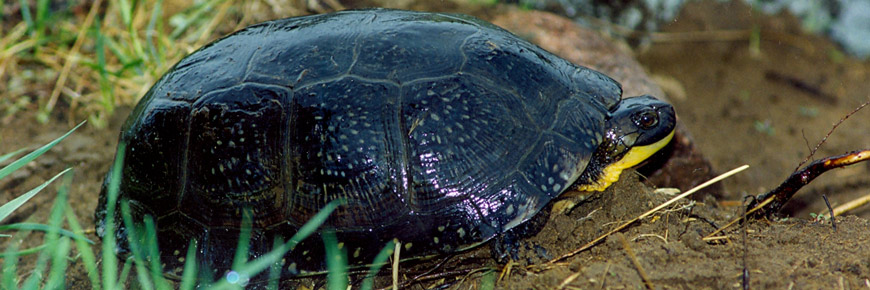
Species at risk
Rideau Canal National Historic Site
Overview
The Rideau Canal corridor has long been recognized as an area of special interest owing to its unique combination of cultural, natural, scenic and recreational values. The landscape of the corridor is a mosaic of agricultural land, wood lots, forests, wetlands, lakes and rivers, scenic shore-lands and urban settlements. This diversity of landscapes and natural resources contributes not only to the national historic significance of the Canal but also to its conservation value and the special relationship that Indigenous people have had with this these lands and waters and the plants and animals living here since time immemorial.
The Rideau Canal’s natural environment is also home to a wide variety of flora and fauna, including many species which are threatened or at risk. There are at least 35 species at risk that are known to be regularly occurring at the site, and the Rideau Canal contains critical habitat for 6 of those species covering more than 75% of the waterway. Additionally, there are many species of cultural importance to Indigenous Peoples, such as the American eel, walleye and furbearers like muskrats and beavers, living in and along the waterway.
Species at risk protection and recovery efforts at Parks Canada places are a key element in the ecosystem management process. Under the species at risk act, Parks Canada works with other federal departments to protect wildlife species in Canada.
What are species at risk?
Species at risk are animals or plants whose numbers have declined significantly; without human intervention they are in danger of disappearing. Most often, species are at risk because of changes to them or their habitat. These changes may occur on a local, regional, or global scale and are usually driven by either human-induced or environmental threats.
At risk species require special consideration for their conservation. In some cases, the population numbers and distribution of species have dropped to extremely low levels, putting them on the road to becoming extinct regionally (i.e. extirpated) or even globally. Some species may need attention to ensure they don't start down this path while others require more immediate help.
Why protect species at risk?
The earth is home to billions of species, many of which have yet to be discovered. A healthy and functioning ecosystem is one with a rich diversity of species. It is estimated that every 20 minutes, another species becomes extinct. In order to sustain the health and well-being of the planet, we must protect the full range of life on earth. Protecting global diversity begins with protecting local species at risk.
How are we helping species at risk?
Parks Canada gives special attention to species listed in the species at risk act (SARA) and to those that have been assessed as being of conservation concern by the Committee on the Status of Endangered Wildlife in Canada (COSEWIC).
In the field, Parks Canada staff are also helping species at risk by monitoring populations of at risk species, protecting and restoring critical habitats, removing invasive plant species and more. Staff at the Rideau Canal carry out several of these activities. As well, staff are developing sustainable water and land use plans, including the development of a species at risk site action plan for the system.
Species at risk on the Rideau Canal
The following is a list of species at risk from the species at risk act or COSEWIC list that you may see in the Rideau Canal or surrounding watershed. You can visit the Government of Canada Species at Risk Registry to learn more about each species.Threatened species
- American Eel
- Bank Swallow
- Black Ash
- Bobolink
- Chimney Swift
- Eastern Meadowlark
- Canada Warbler
- Common Nighthawk
- Dwarf Hackberry
- Eastern Whip-poor-will
- Golden Winged Warbler
- Gray Ratsnake
- Grey Fox
- Lake Sturgeon
- Least Bittern
- Louisiana Waterthrush
- Purple Twayblade
- Western Chorus Frog
- Wood Turtle
- Wood Thrush
Special concern
- American Bumblebee
- Barn Swallow
- Bridle Shiner
- Eastern Milksnake
- Eastern Musk Turtle
- Eastern Pondmussel
- Eastern Ribbonsnake
- Eastern Wood-Pewee
- Evening Grosbeak
- Five Lined Skink
- Flooded Jellyskin Lichen
- Grass Pickerel
- Midland Painted Turtle
- Monarch Butterfly
- Northern Map Turtle
- Northern Sunfish
- Peregrine Falcon
- Rainbow Mussel
- Short-eared Owl
- Snapping Turtle
- Yellow Rail
- Yellow-banded Bumblebee
Species at risk individuals, residences, and critical habitat are taken into consideration during impact assessment and shoreline permitting processes and efforts are made to include conservation gains in these projects. Some projects have included the enhancement of important walleye spawning shoals, invasive species management, creation of turtle nesting areas, and landscape restoration of sites using native species.
Water Chestnut

If you observe a species at risk, or any wildlife, you can help by:
- Reporting wildlife to iNaturalist to be included in the provincial data sets for Ontario,
- Sending ideas you have for protecting species at risk in the Rideau Canal rideau@pc.gc.ca, and
- Engaging with staff who are developing the first species at risk action plan for the Rideau Canal. Opportunities for engagement will be posted on this page and promoted through our media channels.
Find out more
- Date modified :